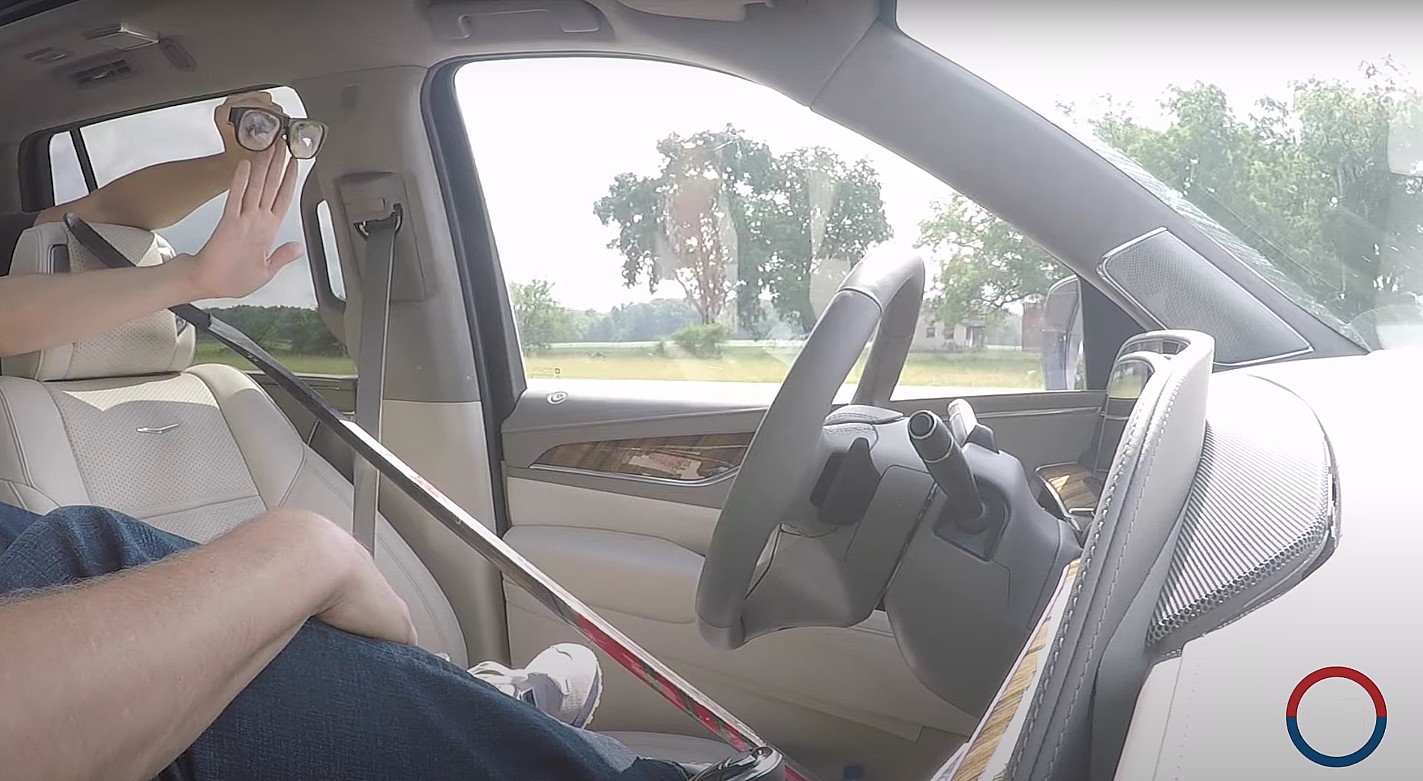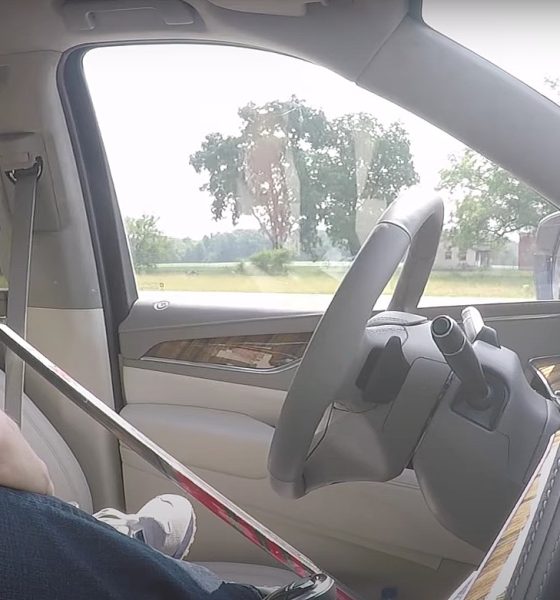

News
Tesla Autopilot is not the only system that can be tricked into operating with no driver
Back in April, news agencies both local and international news covered a particularly controversial test from Consumer Reports. The magazine concluded that Tesla Autopilot was particularly problematic since it could be fooled into operating without a human driver. Granted, Consumer Reports used several hacks and a defeat device to trick the system, but that was the magazine’s point: if a driver wants to, Tesla Autopilot could be fooled into operating dangerously.
A new, more extensive test from Car and Driver has now proven that it is not only Tesla Autopilot that can be tricked into operating dangerously. Unlike Consumer Reports, which published its conclusions without benchmarking Tesla Autopilot with comparable systems like GM’s Super Cruise, Car and Driver actually gathered 17 vehicles from a variety of brands to test how well their driver-assist systems could detect an inattentive or absent driver.
As it turned out, every single system tested by the Car and Driver team fell prey to driver hacks. The motoring publication found that a good number of the vehicles it tested didn’t even stop when the driver unbuckles the seatbelt, and an even greater number of cars were fooled by a defeat device on the steering wheel. Some vehicles from automakers like BMW and Mercedes-Benz performed well against steering wheel defeat devices, though, as they rely on touch response, not pressure from the driver.
In Consumer Reports’ scathing criticism of Autopilot, the magazine noted that other systems such as GM’s Super Cruise are safer since they rely on eye-tracking technology to detect if the driver is paying attention to the road. To test Super Cruise, Car and Driver had to take the vehicle into an actual highway since the system only worked on pre-mapped areas. But even Super Cruise’s eye-tracking system proved vulnerable since the eye-tracking system was fooled by a simple pair of gag glasses with eyes painted on them.
The same was true when Car and Driver evaluated if driver-assist systems would operate without a human in the driver’s seat. Every single system from the 17 vehicles tested by the motoring publication fell prey to simple hacks like a hockey stick on the accelerator. These included Super Cruise, which operated when gag glasses were placed at the driver’s seat.
Car and Driver was careful to highlight that its tests should not be attempted by anyone at any time. Tricking driver-assist systems, after all, is arguably the most foolish thing act that a driver can perform on the road today. But if there is anything that was proven by its mass tests, it is the fact that driver-assist vulnerabilities are not exclusive to Tesla Autopilot. With this in mind, automakers, from Tesla to GM, must continue to improve their systems to make them far better than they are today, hopefully to a point where hacks and defeat devices become ineffective.
Watch Car and Driver‘s test in the video below.
Don’t hesitate to contact us with news tips. Just send a message to tips@teslarati.com to give us a heads up.

News
Elon Musk’s Grok AI to be used in U.S. War Department’s bespoke AI platform
The partnership aims to provide advanced capabilities to 3 million military and civilian personnel.

The U.S. Department of War announced Monday an agreement with Elon Musk’s xAI to embed the company’s frontier artificial intelligence systems, powered by the Grok family of models, into the department’s bespoke AI platform GenAI.mil.
The partnership aims to provide advanced capabilities to 3 million military and civilian personnel, with initial deployment targeted for early 2026 at Impact Level 5 (IL5) for secure handling of Controlled Unclassified Information.
xAI Integration
As noted by the War Department’s press release, GenAI.mil, its bespoke AI platform, will gain xAI for the Government’s suite of tools, which enable real-time global insights from the X platform for “decisive information advantage.” The rollout builds on xAI’s July launch of products for U.S. government customers, including federal, state, local, and national security use cases.
“Targeted for initial deployment in early 2026, this integration will allow all military and civilian personnel to use xAI’s capabilities at Impact Level 5 (IL5), enabling the secure handling of Controlled Unclassified Information (CUI) in daily workflows. Users will also gain access to real‑time global insights from the X platform, providing War Department personnel with a decisive information advantage,” the Department of War wrote in a press release.
Strategic advantages
The deal marks another step in the Department of War’s efforts to use cutting-edge AI in its operations. xAI, for its part, highlighted that its tools can support administrative tasks at the federal, state and local levels, as well as “critical mission use cases” at the front line of military operations.
“The War Department will continue scaling an AI ecosystem built for speed, security, and decision superiority. Newly IL5-certified capabilities will empower every aspect of the Department’s workforce, turning AI into a daily operational asset. This announcement marks another milestone in America’s AI revolution, and the War Department is driving that momentum forward,” the War Department noted.
News
Tesla FSD (Supervised) v14.2.2 starts rolling out
The update focuses on smoother real-world performance, better obstacle awareness, and precise end-of-trip routing, among other improvements.

Tesla has started rolling out Full Self-Driving (Supervised) v14.2.2, bringing further refinements to its most advanced driver-assist system. The new FSD update focuses on smoother real-world performance, better obstacle awareness, and precise end-of-trip routing, among other improvements.
Key FSD v14.2.2 improvements
As noted by Not a Tesla App, FSD v14.2.2 upgrades the vision encoder neural network with higher resolution features, enhancing detection of emergency vehicles, road obstacles, and human gestures. New Arrival Options let users select preferred drop-off styles, such as Parking Lot, Street, Driveway, Parking Garage, or Curbside, with the navigation pin automatically adjusting to the user’s ideal spot for precision.
Other additions include pulling over for emergency vehicles, real-time vision-based detours for blocked roads, improved gate and debris handling, and extreme Speed Profiles for customized driving styles. Reliability gains cover fault recovery, residue alerts on the windshield, and automatic narrow-field camera washing for new 2026 Model Y units.
FSD v14.2.2 also boosts unprotected turns, lane changes, cut-ins, and school bus scenarios, among other things. Tesla also noted that users’ FSD statistics will be saved under Controls > Autopilot, which should help drivers easily view how much they are using FSD in their daily drives.
Key FSD v14.2.2 release notes
Full Self-Driving (Supervised) v14.2.2 includes:
- Upgraded the neural network vision encoder, leveraging higher resolution features to further improve scenarios like handling emergency vehicles, obstacles on the road, and human gestures.
- Added Arrival Options for you to select where FSD should park: in a Parking Lot, on the Street, in a Driveway, in a Parking Garage, or at the Curbside.
- Added handling to pull over or yield for emergency vehicles (e.g. police cars, fire trucks, ambulances).
- Added navigation and routing into the vision-based neural network for real-time handling of blocked roads and detours.
- Added additional Speed Profile to further customize driving style preference.
- Improved handling for static and dynamic gates.
- Improved offsetting for road debris (e.g. tires, tree branches, boxes).
- Improve handling of several scenarios, including unprotected turns, lane changes, vehicle cut-ins, and school buses.
- Improved FSD’s ability to manage system faults and recover smoothly from degraded operation for enhanced reliability.
- Added alerting for residue build-up on interior windshield that may impact front camera visibility. If affected, visit Service for cleaning!
- Added automatic narrow field washing to provide rapid and efficient front camera self-cleaning, and optimize aerodynamics wash at higher vehicle speed.
- Camera visibility can lead to increased attention monitoring sensitivity.
Upcoming Improvements:
- Overall smoothness and sentience.
- Parking spot selection and parking quality.
News
Tesla is not sparing any expense in ensuring the Cybercab is safe
Images shared by the longtime watcher showed 16 Cybercab prototypes parked near Giga Texas’ dedicated crash test facility.

The Tesla Cybercab could very well be the safest taxi on the road when it is released and deployed for public use. This was, at least, hinted at by the intensive safety tests that Tesla seems to be putting the autonomous two-seater through at its Giga Texas crash test facility.
Intensive crash tests
As per recent images from longtime Giga Texas watcher and drone operator Joe Tegtmeyer, Tesla seems to be very busy crash testing Cybercab units. Images shared by the longtime watcher showed 16 Cybercab prototypes parked near Giga Texas’ dedicated crash test facility just before the holidays.
Tegtmeyer’s aerial photos showed the prototypes clustered outside the factory’s testing building. Some uncovered Cybercabs showed notable damage and one even had its airbags engaged. With Cybercab production expected to start in about 130 days, it appears that Tesla is very busy ensuring that its autonomous two-seater ends up becoming the safest taxi on public roads.
Prioritizing safety
With no human driver controls, the Cybercab demands exceptional active and passive safety systems to protect occupants in any scenario. Considering Tesla’s reputation, it is then understandable that the company seems to be sparing no expense in ensuring that the Cybercab is as safe as possible.
Tesla’s focus on safety was recently highlighted when the Cybertruck achieved a Top Safety Pick+ rating from the Insurance Institute for Highway Safety (IIHS). This was a notable victory for the Cybertruck as critics have long claimed that the vehicle will be one of, if not the, most unsafe truck on the road due to its appearance. The vehicle’s Top Safety Pick+ rating, if any, simply proved that Tesla never neglects to make its cars as safe as possible, and that definitely includes the Cybercab.








